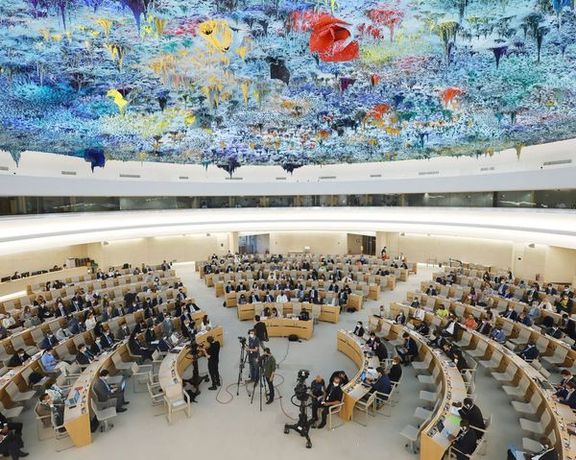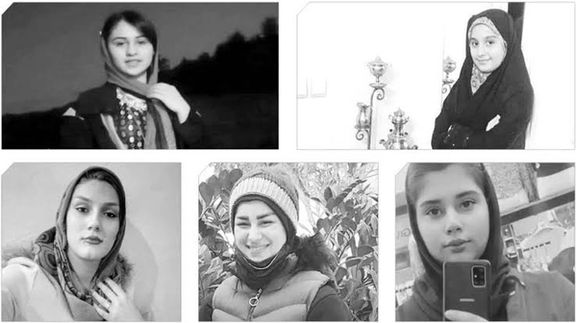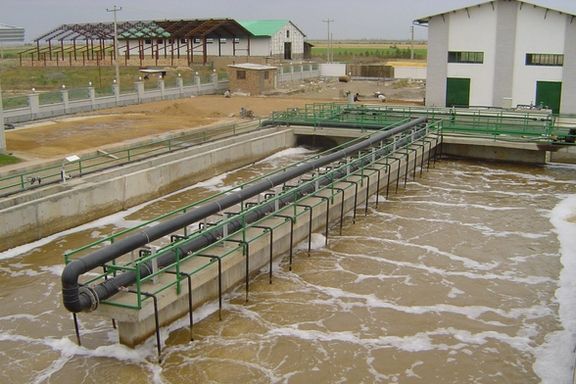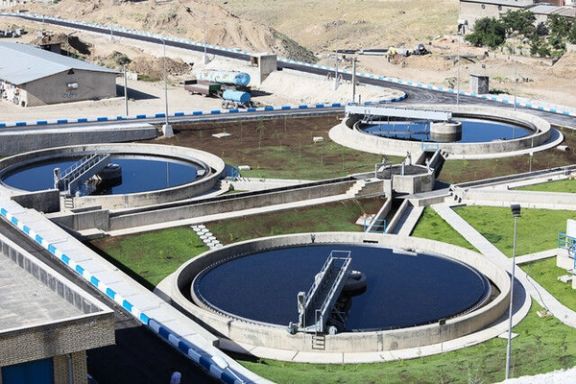Iran Must Stop Executions Of Protesters, Says UN Fact-Finding Mission

A fact-finding mission mandated by the UN urged Iran on Wednesday to stop executing people sentenced to death for anti-government protests that rocked the country last year.

A fact-finding mission mandated by the UN urged Iran on Wednesday to stop executing people sentenced to death for anti-government protests that rocked the country last year.
The death of 22-year-old Mahsa Amini in September 2022 while in the custody of the country's morality police unleashed a wave of mass protests across Iran, marking the biggest challenge to the Islamic regime in decades.
Since then, several people have been hanged for participating in the unrest, and other detainees still face the danger of capital punishment.
"We call on the Iranian authorities to stop the executions of individuals convicted and sentenced to death in connection with the protests and reiterate our requests to make available to us the judicial files, evidence, and judgments regarding each of these persons," Sara Hossain, chair of the Iran Fact-Finding Mission, told the Human Rights Council in Geneva.
The mission also called for the "release all those detained for exercising their legitimate right to peaceful assembly and for reporting on the protests".
Responding to the statement in comments to the Council, Kazem Gharib Abadi, secretary general of Iran's High Council for Human Rights, called the establishment of the fact-finding mission last year "an entirely politically motivated and unacceptable move". He then walked out of the session in protest.
The Iranian representative in the session complained about the use of the word "regime" for the Islamic Republic in several occasions until the chair of the session said he no longer allows such interruptions.
In May, Iran executed three men it said were implicated in the deaths of three members of its security forces during the demonstrations.
With reporting by Reuters

New research has revealed that at least 165 women were killed by one of her family members in Iran within the last two years.
According to an investigative report by Sharq daily citing official sources, 108 women were killed by their husbands, 17 by their brothers, nine by their sons, 13 by their fathers, and 19 by other men in the family.
The findings, which reveal how deeply domestic violence has become embedded in Iranian society, show that on average, a woman was killed by a man in her family every four days.
Out of 165 women who were murdered, 43 were shot, often with hunting rifles, pistols and even Kalashnikovs. Another 40 were stabbed to death and 35 were strangled either by hand, scarves and bedding.
Six women were set on fire, either by pouring gasoline directly on them, or setting fire to the car or the house where the victim was staying. Another 41 victims were killed in other brutal ways such as hammer blows to the head and body and mutilation. Only in 11 cases did the killer commit suicide after the crime.
Family disputes have been quoted as the cause of 87 cases out of 165 murders while 38 cases have been deemed as honor killing, 10 murdered due to financial issues and 30 others where there is no clear cause for the murder.
Perpetrators of honor killings are often not brought to justice in Iran as most families do not demand harsh punishment for them, particularly if the perpetrator is the victim’s father.

Iran's supreme court has upheld the death sentence issued to Abbas Deris, arrested during anti-government protests back in 2019.
His lawyer, Fereshteh Tabanian wrote in a Tweet that her client's death sentence was confirmed but was not communicated to him directly, under charges of moharebeh (enmity against God).
Abbas, 49, and his 29-year-old brother Mohsen, were arrested during the Mahshahr canebrake crackdown in 2019; one of the bloodiest crackdowns in the Islamic Republic. The court acquitted his brother of the moharebeh charges.
Meanwhile, human rights activists warned that Abbas's televised confession had been given under duress. He admitted participating in the protests during the interrogation sessions but denied any role in burning tires and blocking roads.
The unarmed protesters in northern Mahshahr were shot dead by security forces after blocking the street. Security forces fired heavy artillery and set parts of the canebrake on fire when protesters ran towards it to take cover. Eyewitnesses said there were at least 20 deaths on the street and 40 deaths in the canebrake. However, the authorities never provided the exact number of deaths.
Iran's protests in 2019 were ignited by the sudden and sharp increase in fuel prices in the country, and soon turned into an anti-government movement.

Iran’s military cooperation with Russia is “unacceptable,” EU’s foreign policy chief Josep Borrell told the Iranian foreign minister in a phone call on Tuesday.
Borrell tweeted that while speaking about the need to continue dialogue on the JCPOA nuclear deal, he told foreign minister Hossein Amir-Abdollahian that “military cooperation with Russia is unacceptable” and “EU detainees must be freed and human rights respected.”
The European Union, European countries and the United State have been warning Iran against supplying weapons to Russia, since its Shahed Kamikaze drones were deployed by Moscow last year against civilian and military targets in Ukraine. So far, Russia has launched hundreds of these loitering munitions, mostly against infrastructure and centers of population.
In the meantime, France, the United Kingdom and Germany told Iran last week that they plan to retain EU ballistic missile sanctions against Iran set to expire in October, along with a UN ban that was part of the JCPOA deal in 2015.
This signaled that the three countries, signatories of the JCPOA, will technically violate the agreement, which Tehran has already breached with high-level uranium enrichment since 2021.
Iranian government media were silent about the phone conversation Wednesday morning, but the foreign ministry issued two statements, one in Persian and another in English, which were quite different, written for separate audiences.
However, both versions omitted any reference to Borrell’s warning about military cooperation with Russia, and simply mentioned “developments in Ukraine.”
“The Islamic Republic of Iran has always been a supporter of peace and stability in the world, including Ukraine, and in this context, it believes that stopping the war is only possible through political initiatives,” the statement in English quoted Amir-Abdollahian as telling Borrell.
This is hardly the assurance the Europeans seek as they worry about Iranian ballistic missiles finding their way to Russia after October and used against Ukraine, or if the conflict expands beyond the current battlefield.
Tehran’s strategy seems aiming to maintain a certain level of diplomatic interaction with Europe to prevent further sanctions, while strengthening its burgeoning ties with Russia, especially weapons supplies.
British envoy to the United Nations, Barbara Woodward expressed concern Monday that Iran has three times the minimum amount of highly enriched uranium needed to build a nuclear weapon.
Speaking to Iran International’s Maryam Rahmati Woodward said that the regime’s “stockpiles are high, and Iran’s ability to enrich uranium is also very high.”
Woodward is the president of the Security Council in July said, “We'll have a discussion in the Council on the sixth of July on Iran, looking at the Security Council resolution 2231.” The resolution she referred to endorsed the 2015 Iran nuclear agreement, the JCPOA and designated arms limitations on Iran, which might have been violated by drone supplies to Russia.
Referring to the possible reactions by the Islamic Republic in case the UK, France and Germany retain ballistic missile sanctions set to expire in October, Woodward said the situation is causing a lot of concern and that the UK is working closely with France and Germany and the EU on the question of what to do next.
She emphasized that Iran is in “flagrant breach” of resolution 2231, “not least also the way in which it is selling UAVs to Russia for the war in Ukraine.”
“There's quite a lot of concern there and we’ll have a chance to discuss it on the sixth of July,” she added.

Strapped for both cash and water, the Iranian government plans to offer treated wastewater in the energy exchange market.
Mohsen Ardakani, the head of Tehran's water and sewage management, said plans would begin in the coming months but did not elaborate on the mechanism of trade or how the wastewater will be distributed to buyers and consumers.
Dozens of developed countries treat almost all domestic sewage and deliver the treated water to agricultural and industrial sectors. However, the nominal capacity of Iran’s sewage treatment plants is only 5.8 million cubic meters per day, which means that if all of them work at full capacity all year long, they are only able to turn 2.1 billion cubic meters of sewage into treated wastewater, which is less than a quarter of the country’s household water consumption. This means most of the clean water consumed is not treated to be recycled.
Moreover, a quarter of drinking water in the domestic sector is wasted through the distribution and transmission process due to the country's worn-out network. However, according to Ardakani, there are 35 laboratories in Tehran that test water, claiming the distributed water is on par with national and global standards.

All these factors on the backdrop of a drought and low precipitation in the country have led to a severe water crisis in Iran, with regular water cuts and rationing in several cities as well as the capital.
Rainfall in Tehran has decreased by five percent compared to the previous year, and currently the volume of water reserves in dams is down by 40 percent compared to last Iranian year (ended on March 19).
Earlier this week, Mehdi Zare, Professor of the International Research Institute of Seismology, said within the past 25 years almost 25 million Iranians have been displaced amid water scarcity worries. “There are about 12 million marginalized people in Iran, and almost 10 million of this population are directly facing problems caused by the water crisis,” he added.
Water issues have been the main topic of President Ebrahim Raisi’s visits to Iranian provinces in recent months, taking him to Sistan-Baluchestan, Kerman and Khuzestan provinces that have very little clean water and temperature as high as 51 degrees (about 124 in Fahrenheit).
Iranian Energy Minister Ali-Akbar Mehrabian, who was accompanying Raisi in his trip to the central province of Kerman, said last week that at least 10,000 villages in Iran are without drinking water, with about 670 people in Kerman province facing “serious” water scarcity.
Last month, the water was also out in the capital Tehran for several days with tankers distributing water to residents.
In January, CEO of Iran Water and Wastewater Company, Atabak Jafari, issued a warning saying that 270 cities and towns are suffering from acute water shortage as water levels at dams have dropped to critically low levels.
As drought persists across Iran, more underground water is exploited for irrigation, depleting natural reservoirs formed during thousands of years. Old and unregulated irrigation methods, as well as an aging urban water distribution infrastructure compound the shortage.
An inefficient agricultural sector, overgrazing of rangelands and forests, aggressive over-extraction of groundwater resources, and the regime’s mismanagement are among the main causes of water bankruptcy in Iran.
In recent years, massive protests have occurred in several cities against government mismanagement of water resources, harmful dam building, and politically motivated diversion of rivers that have devastated agriculture and drinking water sources in many areas.

In July 2021, water protests erupted in several cities in the oil-rich Khuzestan province that ended with the forceful intervention of police and the Revolutionary Guards. More than ten people were killed and hundreds detained during the protests that lasted a week.
In November of the same year, thousands protested in Esfahan over lack of water for agriculture where the iconic Zayandeh-Roud river has turned into a dry bed over the past few years. The protests soon turned into anti-government unrest.
Head of Esfahan’s crisis management headquarters said Monday that trees along the Zayandeh-Roud river – which starts in the Zagros Mountains are withering out of season.

Russian President Vladimir Putin’s special assistant met Iran's Secretary of the Supreme National Security Council (SNSC) in Tehran on Tuesday.
In his third trip to the Islamic Republic this year, Igor Levitin, who is also Russia’s State Council Secretary, met with Ali-Akbar Ahmadian, the new SNSC secretary, as well as Foreign Minister Hossein Amir-Abdollahian.
During the meeting, Ahmadian stressed the need to speed up the implementation of bilateral agreement, including the project to complete the North-South Transport Corridor and memorandums of understanding (MoUs) in the field of oil and gas.
Russia last year pledged to invest tens of billions of dollars in joint energy projects, but similar deals were made in the past without any progress in implementation.
“Expanding relations with neighbors is a strategic policy and the main agenda of the Islamic Republic,” Ahmadian said.
According to the readout of the meeting in Iranian media, they also talked about the agreement on the construction of the Rasht-Astara railway, a strategic transport corridor that connects the existing railways of the two countries and Azerbaijan.
During his meeting with Amir-Abdollahian, Vladimir Putin’s aide also congratulated the Islamic Republic on its full membership in the Shanghai Cooperation Organization, announced earlier in the day.
